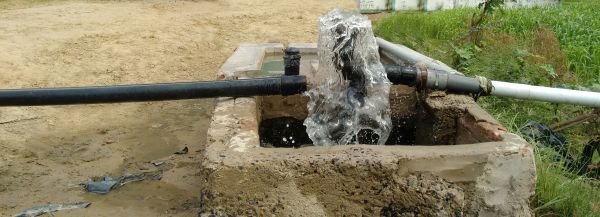Holes in the ground can protect crops from flooding, so why don’t more Indian farmers use them?

India’s farmers are experts in dealing with a monsoonal climate. When an entire year’s water comes in just a few frantic weeks of rainfall, you have to be able to adapt. Consequently, the sub-continent’s farmers have an in-depth knowledge of how to store water and access it during the dry season. But lack of winter water is only one part of the challenge. Extreme rainfall during the main growing season could devastate a harvest overnight. To cope with such variability farmers have often developed local solutions that could be more widely shared and promoted.
Holiyas, also known locally as Bhungroos, are relatively simple groundwater recharge and subsurface storage systems. Starting in the mid-1990s a number of NGOs and other agencies promoted the technology, and a few individual farmers also invested in the approach.
Essentially holiyas are just vertical pipes dug into the ground to an average depth of 9m. They are usually made of 10cm PVC piping, with roughly the bottom third of the pipe perforated. When it rains, water drains down the pipe into the aquifer below. This has the double benefit of reducing the amount of floodwater on the surface, and creating a secure groundwater store that can be used to irrigate crops during the dry season.

To date, holiyas have been tried only in a few villages on the edge of the desert in Gujarat. They are not appropriate for every location, but most useful where surface water logging prevents cultivation of monsoon crops.
They don’t damage the environment, don’t require any deep technological knowledge and are relatively cheap to build. So it comes as a bit of a surprise that they are not widely used. To find out why the IWMI-Tata Water Policy Program carried out an assessment in one region of India in 2015.
A team of researchers surveyed 41 famers in Banaskantha district, Gujarat. Both individuals and village communities were interviewed about the impact of Holiya construction. The results have been recently published as an IWMI-Tata Highlight.
Respondents said that they found the holiyas useful and reported improvements in flood mitigation, drought resilience and cropping. The structures enabled farmers to grow crops during the winter and, in some instances, grow green fodder for livestock during the summer. Holiyas also have a lower environmental impact that either boreholes or canals, yet only a quarter of farmers used them.
Farmers said that they preferred canals as they cost less and were easier to maintain. This was despite the fact that canals have many shortcomings as flood control infrastructure. For instance, canals just shift the burden of excess water to different locations, they do not capture and store it like a holiya could.
Boreholes to access groundwater were also preferred as being easier to dig even though they do not channel water into the aquifer. This makes them far less sustainable in the long run.
So is cost the only reason that holiyas are not more common?
Our research would suggest that the expense of building a holiya is the main drawback for most farmers, says Jonas Bunsen, one of the researchers, currently studying at the University of Utrecht. “Improved groundwater recharge does not seem to be a sufficient incentive for farmers to invest in the new structures.”
The research team believe that the low cost of water access in the survey area could be the main barrier to further adoption – even if borehole or canal water are likely to have higher environmental costs in the long run. Holiya farmers claimed they were able to grow more crops, but clearly this is insufficient incentive on its own to convince others to invest.
Holiyas utilise rainwater and are thus based on a renewable and locally available water source. In contrast, canal water requires huge infrastructural efforts and potentially only shifts the burden of water stress on ecosystems towards different locations. Equally boreholes have their own drawbacks as long-term sources of irrigation water. Gujarat has a long history of aquifer depletion thanks to overuse of borehole water, a challenge that the state government has long struggled to control.
If these environmental costs are not factored in, then canals and boreholes offer farmers the cheapest and easiest water access. If the more environmentally friendly holiyas are to take off, smarter incentives will be needed.
Read the Highlight:
Bunsen, J.; Rathod, R. 2016. Pipe assisted underground taming of surface floods: the experience with Holiyas in north Gujarat. IWMI-Tata Water Policy Research Highlight, 2. 8p.

